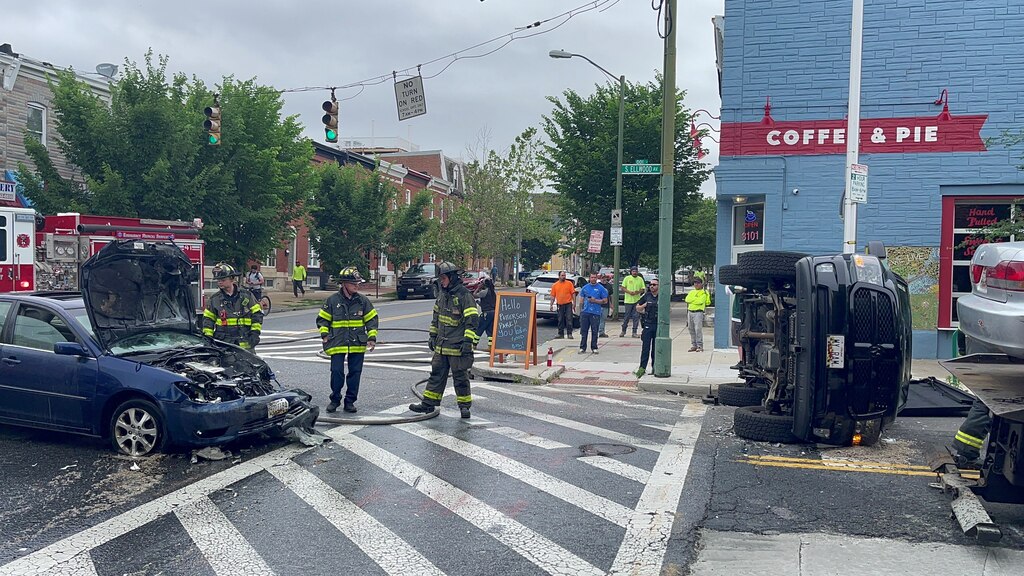Charm City piled up a lot of asphalt in 2024.
Baltimore’s Department of Transportation installed 455 speed humps in neighborhoods around the city last year, significantly more than in previous years, in response to one of the most popular service requests by city residents.
But those requests came in faster than the city could respond to them all. The backlog of residents asking the city and its transportation department to do something to curtail dangerous speeding and aggressive driving has grown — by a lot — since right before the pandemic, when such behaviors starting getting worse across the country.
Matt Folley and other residents have been asking the city for speed humps on South Ellwood Avenue, just north of Highlandtown, for over four years.
“It’s crazy, people drive like lunatics down our street,” said Folley during a recent interview.
“I have a 3-year-old daughter and I don’t even let her out in front of the house,” Folley said. “We have a bunch of kids on our block ... their parents have the same concerns.”
The toolbox for traffic calming starts with speed humps, which force cars to slow down to go over them, but includes new crosswalks or signage, intersection “bump outs” that give more space to pedestrians at street corners, or bigger roadway changes, like chicanes.
In 2019, new requests outnumbered completed ones more than 12 to 1 citywide, according to figures shared by the Baltimore City Department of Transportation. That ratio has since come down, but the number of total new requests also has tripled. When a request isn’t filled in the same year, it gets pushed into the following “paving season” (crews can lay asphalt only above a certain temperature).
Such delays happened in roughly a dozen locations around Baltimore in 2024, including Folley’s neighborhood.
He can remember five or six bad wrecks in the past couple of years — he sends photos of them to the transportation department as a not-so-gentle reminder of their request.
“Adding another major 3 car accident from last night with someone trying to beat the red light on ellwood. Someone is going to die,” he wrote last July.

A City Council member got involved; a state delegate got involved — they toured the street with neighbors to see it for themselves. But the decision to install any traffic calming was ultimately up to the transportation department.
The process to get speed humps takes time. Here’s how it’s supposed to work:
- Resident or neighborhood submits a “traffic calming” 311 request, either by phone or using the online portal;
- Transportation officials conduct a field investigation with vehicle speed data collection that can take up to four weeks;
- Engineers create a schematic for the roadway;
- The Fire Department reviews the plan: That can take as little as one week or as long as two months if they have concerns regarding emergency vehicle response times;
- Neighbors close to the proposed speed humps get postcards with information and have the opportunity to offer feedback, comments or complaints. This can take 6-8 weeks;
- Once approved, the project gets placed in the queue to await construction.
The 455 speed humps were installed last year at 144 new locations. Baltimore’s 2nd District, the Northeast Baltimore area represented by Councilwoman Danielle McCray, led the pack with 26. The 5th District in the city’s Northwest, represented by Councilman Isaac “Yitzy” Schleifer, got the least with just one.
The process doesn’t always run perfectly.
On South Ellwood, Folley said, aggressive driving is worst around rush hours when people drive the most. He said he saw the city worker who came out to his block to do the speed test — in the middle of the day.
“She just took a couple of measurements and then drove away,” Folley said.
Officials then told Folley that the block wasn’t a priority based on the speed readings, he said.
Last May, then-director of the department Corren Johnson emailed Folley to tell him their block had passed all the hurdles and was scheduled for speed hump installation before the end of 2024.
Seven months later, a transportation official wrote to Folley that they were “moving forward with the standard process” and that the next step was to distribute postcards to neighbors, something they did already.
At some point, Folley wondered if he could find a way to apply for grants or fundraise with his neighbors to pay for the installation themselves. The city never responded, he said.
On New Year’s Eve, the city installed two temporary speed bumps.
The new year offers Baltimore a chance to turn over a new leaf, though.
Veronica McBeth, a former member of the Biden administration, took over as the head of the transportation department last week. Transportation advocates have been praising the appointment ever since mayor Brandon Scott announced it.
And though the state’s transportation budget is teetering on unstable ground, funding that trickles down to Baltimore for road maintenance is more stable than in years past.
It’s too little, too late for Folley and his family, though. They plan to move to Baltimore County in search of quieter streets and respite from the speeding traffic.
“It’s been a good house, it’s a good neighborhood, I just can’t have my kid out front,” Folley said. “Something terrible’s going to happen.”





Comments
Welcome to The Banner's subscriber-only commenting community. Please review our community guidelines.